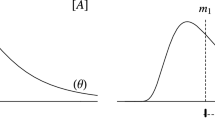Abstract
From a statistical perspective, the Fieller–Creasy problem which involves inference about the ratio of two normal means has been quite challenging. In this study, we consider some solutions to this problem, based on an objective Bayesian model selection procedure. First, we develop the objective priors for testing the ratio of two normal means, based on measures of divergence between competing models. We then propose the intrinsic priors and the fractional priors for which the Bayes factors and model selection probabilities are well defined. In addition, we prove that the Bayes factors based on divergence-based priors, as well as intrinsic and fractional priors, are consistent for large sample sizes. Finally, we derive the Bayesian reference criterion from the Bayesian decision theory framework, based on the intrinsic discrepancy loss function. The behaviors of the Bayes factors are compared by undertaking a simulation study and using a case study example.
Similar content being viewed by others
References
Barbieri MM, Liseo B, Petrella L (2000) Bayes factors for Fieller’s problem. Biometrika 87:717–723
Bayarri MJ, García-Donato G (2007) Extending conventional priors for testing general hypotheses in linear model. Biometrika 94:135–152
Bayarri MJ, García-Donato G (2008) Generalization of Jeffreys divergence-based priors for Bayesian hypothesis testing. J R Stat Soc Ser B 70:981–1003
Berger JO, Bernardo JM (1992) On the development of reference priors (with discussion). In: Bernardo JM et al (eds) Bayesian statistics IV. Oxford University Press, Oxford, pp 35–60
Berger JO, Pericchi LR (1996) The intrinsic Bayes factor for model selection and prediction. J Am Stat Assoc 91:109–122
Berger JO, Mortera J (1999) Default Bayes factors for nonnested hypothesis testing. J Am Stat Assoc 94:542–554
Bernardo JM (1977) Inferences about the ratio of normal means: a Bayesian approach to the Fieller–Creasy problem. In: Recent developments in statistics, proceedings of the 1976 European meeting of statisticians, pp 345–350
Bernardo JM, Rueda R (2002) Bayesian hypothesis testing: a reference approach. Int Stat Rev 70:351–372
Bernardo JM (2005) Intrinsic credible regions: an objective Bayesian approach to interval estimation (with discussion). Test 14:317–384
Bernardo JM, Pérez S (2007) Comparing normal means: new methods for an old problem. Bayesian Anal 2:45–58
Carlin BP, Louis TA (2000) Bayes and empirical Bayes methods for data analysis. Chapman and Hall, London
Creasy MA (1954) Limits for the ratio of means. J R Stat Soc B 16:186–194
Datta GS, Ghosh M (1995) Some remarks on noninformative priors. J AM Stat Assoc 90:1357–1363
De Santis F, Spezzaferri F (1999) Methods for default and robust Bayesian model comparison: the fractional Bayes factor approach. Int Stat Rev 67:267–286
Fieller EC (1954) Some problems in interval estimation (with discussion). J R Stat Soc B 16:175–185
Jeffreys H (1961) Theory of Probability, 3rd edn. Oxford University Press, Oxford
Kappenman RF, Geisser S, Antle CF (1970) Bayesian and fiducial solutions to the Fieller–Creasy problem. J R Stat Soc Ser B 32:331–340
Kass RE, Vaidyanathan S (1992) Approximate Bayes factors and orthogonal parameters, with application to testing equality of two binomial proportions. J R Stat Soc Ser B 54:129–144
Lee WD, Kim DL, Kang SG (2007) Bayesian inference for Fieller–Creasy problem using unbalanced data. J Korean Stat Soc 36:489–500
Liseo B (1993) Elimination of nuisance parameters with reference priors. Biometrika 80:295–304
Moreno E (1997) Bayes factor for intrinsic and fractional priors in nested models: Bayesian robustness. In: Yadolah D (ed) L1-statistical procedures and related topics, vol 31. Institute of Mathematical Statistics, Hayward, pp 257–270
Moreno E, Bertolino F, Racugno W (1998) An intrinsic limiting procedure for model selection and hypotheses testing. J Am Stat Assoc 93:1451–1460
Mukerjee R, Ghosh M (1997) Second order probability matching priors. Biometrika 84:970–975
Ott RL (1998) An introduction to statistical methods and data analysis. Duxbury Press, Belmont
Pérez J, Berger JO (2002) Expected posterior prior distributions for model selection. Biometrika 89:491–512
Pérez S (2005) Objective Bayesian methods for mean comparison, PhD Thesis, Department of Statistics, University of Valencia
Phillipe A, Robert CP (1998) A note on the confidence properties of reference priors for the calibration model. Test 7:147–160
Reid N (1995) Likelihood and Bayesian approximation methods (with discussion). In: Bernardo JM et al (eds) Bayesian statistics V. Oxford University Press, Oxford, pp 351–368
Robert C (1996) Intrinsic losses. Theory Decis 40:191–214
Stephens DA, Smith AFM (1992) Sampling–resampling techniques for the computation of posterior densities in normal means problems. Test 1:1–18
Yin M, Ghosh M (2001) ayesian and likelihood inference for the generalized Fieller–Creasy problem. In: Ahmed SE, Reid N (eds) Empirical Bayes and likelihood inference. Springer, New York, pp 121–139
Zellner A, Siow A (1980) Posterior odds ratio for selected regression hypotheses. In: Bernardo JM et al (eds) Bayesian statistics 1. University Press, Valencia, pp 585–603
Zellner A, Siow A (1984) Basic issues in econometrics. University of Chicago Press, Chicago
Acknowledgements
The authors would like to thank the editor, associate editor and two anonymous referees for their thorough review of the paper and their valuable suggestions that improved the original version of the manuscript. Sang Gil Kang is one of first authors in this paper.
Author information
Authors and Affiliations
Corresponding author
Electronic supplementary material
Below is the link to the electronic supplementary material.
Rights and permissions
About this article
Cite this article
Kim, D.H., Lee, W.D., Kang, S.G. et al. Objective Bayesian tests for Fieller–Creasy problem. Comput Stat 34, 1159–1182 (2019). https://doi.org/10.1007/s00180-018-0853-4
Received:
Accepted:
Published:
Issue Date:
DOI: https://doi.org/10.1007/s00180-018-0853-4



